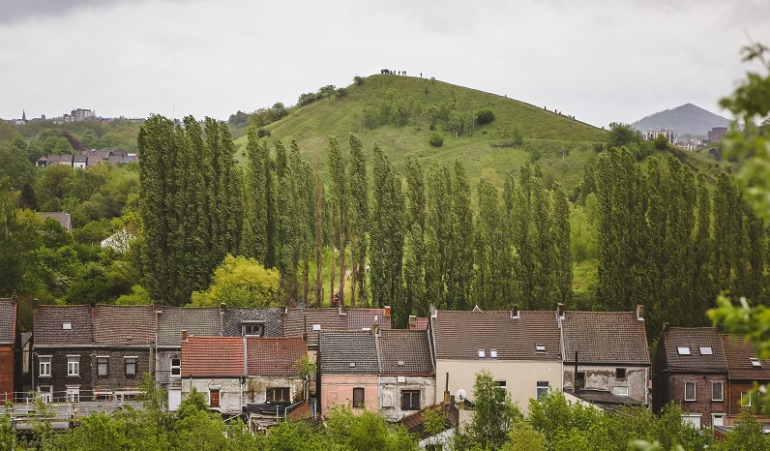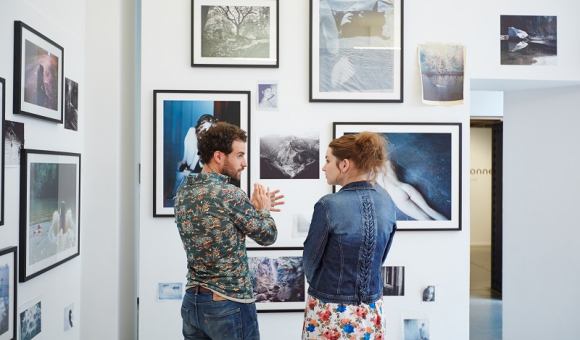
To discover a different side to Charleroi, there are two must-see spots. The Photography Museum, with its long-established reputation, offers a feast for your eyes with its new temporary exhibitions. The Boucle noire, meaning Black Loop, is a hike that takes you off the beaten track and on a discovery of the Pays noir's industrial past. A change of scenery, guaranteed.
Europe's largest Photography Museum
Did you know that one of Europe's largest and most important museums dedicated to photography is located in Charleroi? In Mont-sur-Marchienne to be precise. Housed in a former Carmelite convent, the Photography Museum, a contemporary art centre of the Wallonia-Brussels Federation inaugurated in 1987, boasts a 6,000 m² collection of almost 100,000 photographs, including over 800 on permanent display, and 1.5 million negatives. More than 13,000 titles and 4,000 files on photography can be consulted free of charge in the museum's library. A visit here is also an opportunity to learn more about the art of photography, for those who are interested. A fun, educational area, the Discovery Trail introduces you to the key concepts of photography. The Darkroom will teach you the magic of developing photographs. The Digital Laboratory enables children aged 6 to 12 to learn about the technological evolution of photography. The Learning Room is home to the cyanotype workshop (a photographic printing method that produces distinctive Prussian blue prints), as well as training, workshops and taster courses for birthday parties. The shop offers exclusive publications and books dedicated to photography. To get some fresh air after your visit, there's nothing better than a walk in the park, boasting 85 hectares of remarkable trees listed in the Walloon heritage register. The Photography Museum also features temporary exhibitions. There are currently three exhibitions on offer that are not to be missed!
Peter Knapp, fashion photography
Firstly, the exhibition devoted to the great Swiss photographer, Peter Knapp. After studying at the Zurich School of Applied Arts, he moved to Paris in 1951. A few years later, Hélène Lazareff, founder of Elle magazine, launched his career when she asked him to develop the magazine's editorial line. Knapp then translated his graphic concepts for the ORTF programme Dim Dam Dom. With Jean-Christophe Averty, he revolutionised the way television programmes looked in the 1960s. He left Elle and returned as artistic director in the 70s. Between 1983 and 1994, he taught at the Ecole Supérieure des Arts Graphiques in Paris. Thanks to Knapp and other great photographers, fashion photography has helped to shape the contemporary eye and familiarise people with the language of photography. Peter Knapp. Mon temps (My time), until 26 May.
Thomas Chable, an African passion
A photographer of here and elsewhere, Thomas Chable has travelled to a number of countries, mainly in Africa, as well as to Mexico and France. For almost thirty years, he has put Africa at the heart of his work. Among his most important series is Odeurs d’Afrique (Smells of Africa), a journey along the Niger River. In recent years, he has taken a greater interest in Ethiopia. This exhibition is a selection from various series, mixing earlier and more recent works by the photographer. Born in Brussels, Thomas Chable studied under the great Liège photographer Hubert Grooteclaes, renowned for his artistic blurs. Professor of photography at the Académie des Beaux-Arts in Liège, Thomas Chable lives in the Liège region. Thomas Chable. Au-dessus des nuages (Above the clouds), until 26 May.
Elliot Ross, seeing animals differently
Elliot Ross presents a gallery of portraits, with the models appearing to pose as if against a black background in a studio. The decision to shoot in black and white leads viewers to rather stare at the animals. The artist's photographs magnify his subjects in the care he takes in producing them. Born in Chicago in 1947, Elliot Ross, who studied art at the San Francisco Art Institute, lives and works in San Francisco and New York. He has participated in numerous solo and group exhibitions around the world and has various publications. Elliot Ross. Seeing Animals, until 26 May.
www.museephoto.be/en/PageAccueil-en
La Boucle noire, the true face of Charleroi
If you're looking for another change of scenery, don't miss the Boucle noire (Black Loop) walk. This 23 km hike in and around Charleroi reveals the true face of the Pays Noir and teaches you about its industrial past. Departing from Charleroi-Sud station, discover the slag heaps, the wastelands and some of the tourist highlights of this little-known city, particularly its western outskirts between the Sambre and the Charleroi-Brussels Canal. You'll pass through Marchienne-au-Pont, Monceau-sur-Sambre, Roux-Martinet, Marchienne-Docherie and Dampremy. On the agenda you'll find contrasting landscapes and the legacy of mining and the steel industry. Discover the remains of the iron and steel industry with blast furnace 4, as well as the château in Marchienne and the one in Monceau-sur-Sambre with its beautiful English park. You'll pass the Château Cartier, the family birthplace of French author and academician Marguerite Yourcenar. Small green paths alternate with ancient alleyways and workers' housing estates with their Japanese cherry trees. This walk offers the chance to climb four slag heaps, the legacy of the mining industry, now covered in greenery as nature retakes its rightful place. The Martinet slag heaps and the chain of slag heaps at Dampremy and La Docherie are linked by passages, paths and short crossings of secondary roads. The summits offer breathtaking views over the city centre.
If you want to get away from the usual tourist routes, the Boucle noire, revealing both the beautiful and not-so-beautiful sides of Charleroi, has got to be next on your list. Bring good shoes and allow a full day to complete the loop. It's also possible to just do part of it, with a shorter 5 km version offered by the City of Charleroi. Maps are available from the Eden cultural centre, the Maison du Tourisme (tourist office) or the youth hostel in the city centre.
The Boucle noire was initiated in 2016 by Chemins des terrils and Sentiers de Grande Randonnée. It was Micheline Dufert and Francis Pourcel, a couple of retired former punk musicians who spend their days hiking, who came up with the idea for this special trail. Their motivation was to showcase the contrasting landscapes that symbolise Charleroi's mining and industrial past. The markings were created by Sentiers de Grande Randonnée using triangular slabs reminiscent of the shape of the slag heaps. The walk is now part of the "Sentiers des terrils", the GR 412, marked out in white and red and stretching 300 km across the former mining basins from Bernissart in Hainaut to Blegny in the province of Liège.
By Jacqueline Remits
